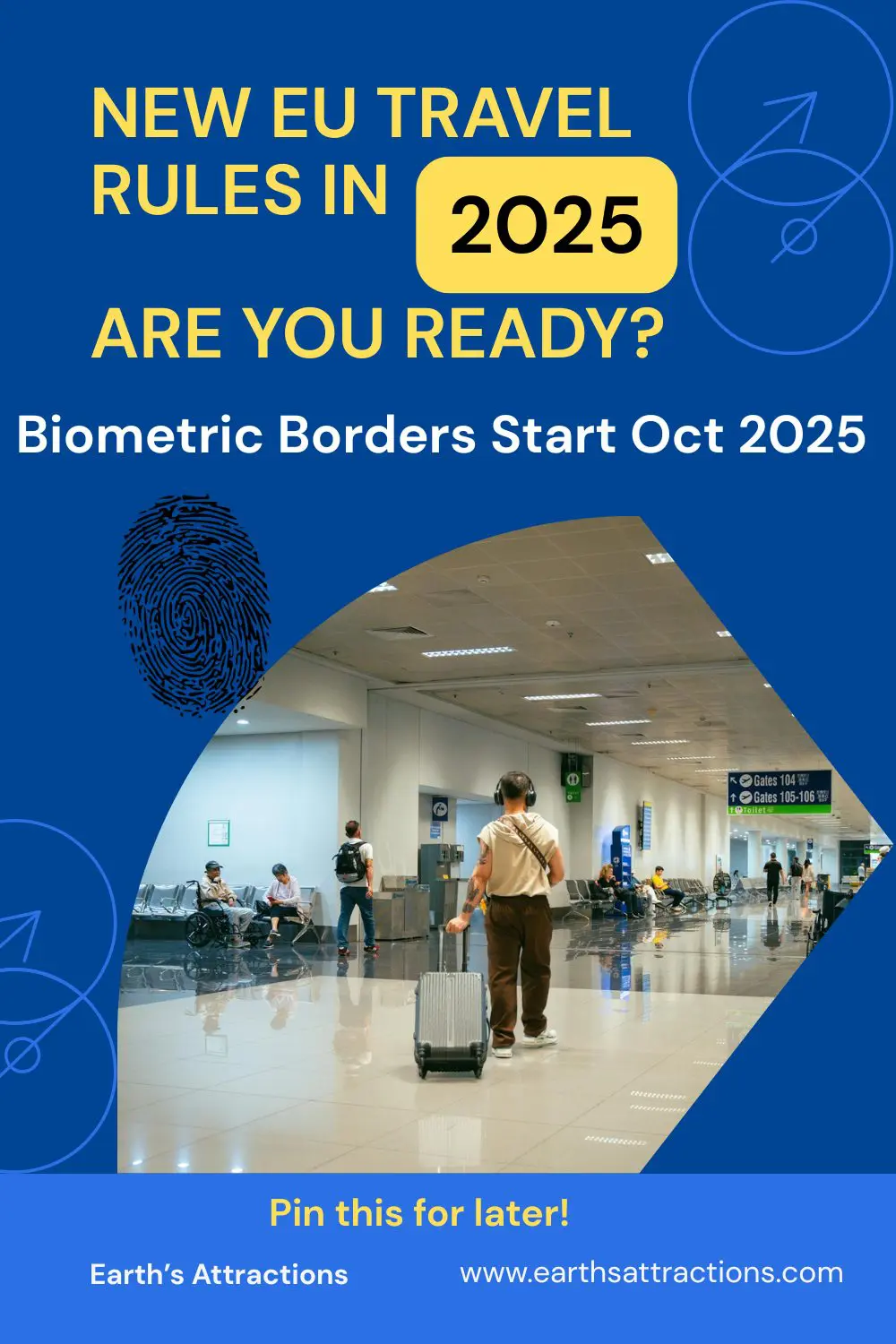
Europe’s border crossings are entering a new era. The old passport stamping process is being replaced by high-tech biometric checks under the EU’s Entry/Exit System (EES). Here’s how it works, what countries are involved, and what every traveler, whether from inside or outside Schengen, must do to prepare.
And yes, I know, we are all resistant to change. And all things have pros and cons (I will write about these below).
Right now, it is very important to know that things will change. Soon. And to understand what it means for each of us! I am including information only from the official sources, so that you have all the details you need.

What Is the EU Entry/Exit System (EES)?
The Entry/Exit System (EES) is the EU’s new automated biometric border control program designed to replace manual passport stamping. Instead of a simple ink stamp, your facial image and fingerprints will be scanned, along with your travel document data, and logged in a secure central database.
Why the change?
- To speed up border crossings
- To improve security against identity fraud and overstays
- To simplify record-keeping for travelers and border authorities
This system applies to non-EU nationals traveling to or leaving the Schengen Area for short stays (up to 90 days in any 180-day period).
When Does EES Start and Which Countries Are Included?
The system progressively starts in October 2025, with full roll-out by early 2026.
Applies to:
- All Schengen Area countries (27 states including France, Germany, Italy, Spain, Netherlands, etc.)
- Associated countries: Norway, Iceland, Switzerland, Liechtenstein
Does NOT apply to:
- EU/Schengen citizens
- Holders of long-term residence permits or local ID cards (though checks may still occur)
(Source: European Commission EES Guide, Council of the EU Press Release)
What Does This Mean for Travelers?
Here’s the impact in plain language:
Good news:
- Faster crossings once fully implemented
- No more passport stamping confusion (the system will auto-calculate your 90/180-day limit)
Challenges:
- Longer lines during early rollout (as systems stabilize)
- Mandatory biometric capture (face + fingerprints)
- Increased data security concerns

Who Is Affected by the New Biometric System?
- Non-EU travelers from countries that do not need a visa (e.g., U.S., Canada, UK, Australia, Japan)
- Those needing a short-stay visa (EES logs entries/exits automatically)
Important: From mid-2026, ETIAS (European Travel Information and Authorisation System) will also apply to visa-exempt travelers, but EES launches first.
(Source: Official ETIAS page)
How the EES Works at the Border
At the first entry to the Schengen Area:
- Present passport
- Scan face and four fingerprints at a kiosk
- Data stored for 3 years (can be extended if necessary)
On future trips:
- Quick biometric verification instead of manual checks
The system will automatically record:
- Date & place of entry/exit
- Refusal of entry if applicable
(No more guessing if you’ve used your 90-day allowance!)
(Source: the 3 official sources mentioned above – as for the information included below)
How to Prepare for Europe’s Biometric Borders: Traveler Checklist
For all travelers:
- Check your passport validity (minimum 3–6 months recommended)
- Arrive earlier than usual (extra 30–45 mins) during rollout
- Remove hats, sunglasses, and masks at kiosks for facial scans
- Keep hands clean for fingerprint scanning
Frequent Flyers & Business Travelers:
- Review data privacy policies of airlines and airports
- Carry a backup digital ID app (where available)
- If traveling with sensitive work data:
- Use encrypted laptops
- Avoid public Wi-Fi at kiosks
- Consider temporary devices if going to high-risk regions after Europe
Families:
- Children will also need facial images (fingerprint rules vary by age)
- Practice with kids so they aren’t scared at scanners
Privacy & Data Concerns: What You Should Know
This is perhaps the most important element of all, because we are all concerned about our data (of any kind).
The official information states that the biometric data will be stored in a central EU database for three years (extended for visa holders). While the EU promises GDPR-level security, privacy experts caution about:
- Potential data breaches
- Cross-border sharing with non-EU authorities
- Profiling risks
Tip: Review your airline’s privacy policy when booking – some carriers integrate pre-clearance.
What About ETIAS? Will You Need Both?
Yes – eventually. Here’s the timeline:
- October 2025: EES starts (biometric entry/exit)
- Mid-2026: ETIAS becomes mandatory for visa-free travelers
ETIAS = Pre-travel authorization (like ESTA for the U.S.)
EES = On-site biometric registration at the border
Pros and Cons of Europe’s Biometric Borders

I mentioned above that I will go a bit into the good and bad for this new measure. So, there they are:
Pros:
- Faster processing (once stabilized)
- Accurate stay calculations
- Enhanced security
Cons:
- Longer waits during the early months
- Privacy concerns
- Added complexity for travelers unfamiliar with digital processes
Countries Outside Schengen: What Changes for You?
- If you’re entering Schengen from the UK, U.S., Canada, or Asia, expect biometric registration on arrival.
- If you’re leaving Schengen to go back home, exit will also be logged, making overstays almost impossible.
Extra FAQ
Q: Does EES replace the passport stamp?
Yes, passport stamping will be phased out in favor of biometric and digital entry records.
Q: Will EU citizens need EES?
No, it applies only to non-EU nationals entering the Schengen Area for short stays.
Q: How long is data kept?
Three years for travelers without a visa overstay.
So What Does This Mean for Your Next Trip?
Europe’s shift to biometric border control marks a new travel era, aiming to be more secure, but also more complex during rollout. If you plan to visit Europe after October 2025, allow extra time, prep your documents, and stay informed. The reward? Faster, smarter travel once systems stabilize.


Photo source: 1, 2, 3
More amazing articles for you:
Please visit:
Our Sponsor
